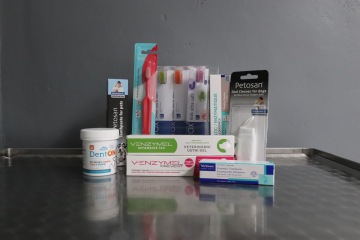Prevention of plaque and tartar
3 years ago
How do plaque and tartar form and what it does?
Plaque is a gummy substance that forms on the teeth within hours of eating. Within 24 hours, the plaque begins to harden by combining with the salts that are present in the saliva. As plaque continues to build up and mineralize, it eventually turns into tartar. Tartar is rough and porous and can form above and below the gum line.
Tartar damages teeth and gums in two ways:
Tartar forms a rough surface that serves as a place for bacteria to grow and multiply in the mouth. The bacteria can cause inflammation of the gums (gingivitis), which often results in painful bleeding. Gingivitis often progresses to periodontal disease, which leads to further inflammation, pain and tooth loss (see Dental Disease for more information). As tartar builds up along the gum line, it pushes the gums away from the roots of the teeth and gum recession occurs. This results in exposing the sensitive part of the tooth without enamel, which causes sensitivity and pain.
Bacteria on tartar can be released into the bloodstream and then deposit in various organs, including the heart and kidneys, causing infection.
How can I prevent plaque and tartar from forming on my pet's teeth?
Feed your pet a recognized dental diet (VOHC), which slows the accumulation of plaque and tartar by mechanical or chemical means. By limiting the formation of dental plaque, the formation of tartar is significantly reduced.
Brush your pet's teeth daily. This is one of the most effective ways to remove plaque before it turns into tartar. Do not use human toothpaste as it contains ingredients that can cause stomach upset if ingested.
Use approved water additives by VOHC and dental gels containing chlorhexidine approved for veterinary use to reduce the number of bacteria in the mouth.
Offer chew toys and dental treats that are specifically designed to help reduce or remove mild tartar. Never let dogs chew on bones, horse hooves, antlers (horns), ice cubes or nylon toys that could break teeth.
Visit your vet once every 6-12 months and let him check the condition of your pet's teeth. Regular dental cleanings are just as important for pets as they are for humans and will help prevent irreversible damage to the gums and roots.
How do I know that the tartar prevention product I am using is really working?
The VOHC Veterinary Oral Health Council only accepts dental products that are safe and have been shown to reduce plaque and tartar build-up based on rigorous scientific studies. You can view the list of accepted products on the website www.vohc.org.
Can I use human toothpaste?
Definitely not. Human toothpastes should never be used on dogs. Toothpastes for human teeth contain ingredients that are not meant to be swallowed and can irritate the stomach and intestines if swallowed. Pastes also commonly contain a higher salt content, which can also cause health problems. You should also avoid using baking soda to brush your teeth. Baking soda is highly alkaline and when ingested can upset the acid balance in the stomach and digestive tract.
Why to use toothpaste recommended for pets?
Pet toothpastes are non-foaming, safe to swallow, and available in flavors that appeal to dogs and cats, including poultry, beef, malt, and mint. If you use a product that tastes good, your pet is more likely to enjoy the whole experience. In addition to tasting great, many of these toothpastes contain enzymes that are designed to help chemically break down plaque, reducing the amount of time you spend brushing your pet's teeth.

